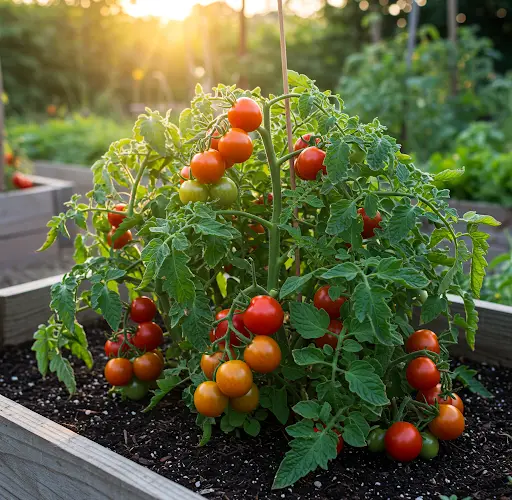How to Protect Tomato Plants from Heat and Boost Their Resilience Naturally
Growing tomatoes can be a truly rewarding experience, but anyone who has tended these sun-loving plants knows that extreme summer heat can quickly become a major threat. While tomatoes thrive in warm climates, prolonged exposure to temperatures above 30°C (86°F) can cause a range of problems—from poor fruit development to increased vulnerability to disease.
Fortunately, there are practical and natural ways to shield tomato plants from heat stress and help them grow stronger, healthier, and more productive. This guide outlines why heat protection is crucial, shares key strategies for cooling your plants, and reveals a simple yet effective homemade recipe that nourishes tomatoes and helps them resist stress.
Why Tomatoes Need Protection from Excessive Heat
Tomatoes are tropical plants, and they certainly enjoy the sun. However, like most living organisms, there is a limit to what they can tolerate. Prolonged exposure to high temperatures, especially when combined with dry conditions, can lead to multiple problems:
-
Sunscald and Fruit Burns: Direct exposure to intense sunlight can cause burns on the fruit, leading to discolored, leathery patches that make the tomatoes unattractive and reduce their shelf life.
-
Interrupted Photosynthesis: Heat stress can disrupt the photosynthetic process, slowing growth and reducing the energy the plant needs to produce flowers and fruit.
-
Blossom Drop: Temperatures consistently above 30°C can cause flowers to drop before they are pollinated, leading to fewer fruits on the plant.
-
Weakened Immune System: Stress from heat makes plants more vulnerable to pests and diseases, reducing their resilience and overall productivity.
Understanding these risks is the first step toward effective protection. The good news is that there are several straightforward ways to help your tomatoes cope with heat waves and flourish throughout the growing season.
Effective Strategies for Protecting Tomatoes from Heat
1. Watering Wisely:
Tomatoes need consistent and deep watering, especially during hot weather. Water early in the morning so the plants are hydrated before the heat of the day sets in. This helps maintain turgor pressure in plant cells and prevents wilting. Avoid watering in the evening to reduce the risk of fungal diseases.
2. Mulching:
Apply a layer of organic mulch, such as straw, dry leaves, or shredded bark, around the base of your tomato plants. Mulch conserves soil moisture, suppresses weeds, and keeps the root zone cool, even on hot days.
3. Providing Shade:
Consider using shade cloth, old bed sheets, or garden netting to protect your tomato plants from direct afternoon sun. A 30-50% shade cloth is ideal—it reduces light intensity while still allowing air circulation and some sunlight.
4. Soil Improvement:
Amend your soil with compost or other organic matter. This enhances the soil’s structure and its ability to retain moisture, ensuring that the plants have access to water even during dry spells.
Natural Remedies to Strengthen Tomato Plants
Alongside physical measures, natural tonics can further improve the plant’s ability to resist stress. Two simple kitchen ingredients—turmeric and baking soda—can provide significant benefits when used properly.
Turmeric Tonic for Tomatoes
Turmeric is well-known for its anti-inflammatory and antimicrobial properties, and it can also help protect plants from fungal infections. As a bonus, turmeric may contribute to improved overall plant health and vigor.
How to Use:
-
Mix 1 teaspoon of turmeric powder into 1 liter of water.
-
Stir thoroughly until fully dissolved.
-
Water the tomato plants with this solution once every two weeks.
This treatment not only helps reduce the risk of disease but also supports the plant’s immune response during periods of heat stress.
Baking Soda Spray
Baking soda, or sodium bicarbonate, is another powerful ally in the garden. It helps neutralize soil acidity and combats powdery mildew, a common fungal disease in tomatoes.
How to Use:
-
Dissolve 1 teaspoon of baking soda in 1 liter of water.
-
Pour the mixture into a spray bottle.
-
Lightly spray the tomato leaves once per week, preferably in the early morning or late afternoon.
Make sure to avoid excessive application, as too much baking soda can potentially alter the leaf surface and soil balance.
Final Thoughts
Tomatoes are sensitive to their environment, but with the right care and a little natural support, they can thrive even in challenging weather conditions. Simple techniques like mulching, shading, and consistent watering, paired with turmeric and baking soda treatments, can help your plants stay strong, produce more fruit, and resist the damaging effects of extreme heat.
By applying these tips, you not only protect your tomatoes but also reduce the need for chemical fertilizers and fungicides—creating a healthier, more sustainable garden.



